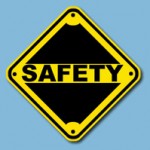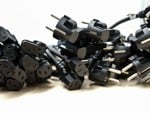 Going online has become part of everyday life, whether it is for everyday activities such as shopping, sending email or paying bills, and managing your accounts. But data breaches, in all their forms, can potentially expose the personal information that we share online, putting consumers at risk of identity theft.
Going online has become part of everyday life, whether it is for everyday activities such as shopping, sending email or paying bills, and managing your accounts. But data breaches, in all their forms, can potentially expose the personal information that we share online, putting consumers at risk of identity theft.
According to the 2015 Travelers Consumer Risk Index, 59% of Americans worry about online identity theft. Fortunately, there are steps that consumers can take, including not opening unsolicited emails and avoiding unsecure websites, to protect their personal information while online.
The following tips can help you learn how to help stay safe online:
Online Shopping
- Research potential retailers to make sure they are reputable and have a secure network and website. Try to avoid buying from a site that does not have a secure socket layer (SSL) encryption installed. In order to do this, look for the ‘s’ at the beginning of a URL – HTTPS:// instead of HTTP:// – to help determine if a site is SSL secured.
- Read the site’s privacy policy to learn how the personal information you provide will be used.
- Use only one credit card for online purchases. Be sure to read statements when received to check for fraudulent or unknown charges or activity.
- If you receive an email regarding sales or discounts from a particular retailer, log on directly to the official website for the business. Avoid linking to it from an unsolicited email.
Emails and Attachments
- Do not send personal information in email or instant messages. Emails are out of your control once sent, and can be easily intercepted.
- Do not click on links you receive by email or encounter online that are suspicious or from unknown sources. Only accept and click if it:
- Comes from someone you know.
- Comes from someone you have received mail from before.
- Is something you were expecting.
- Does not look odd with unusual spellings or characters.
- Passes your anti-virus program test.
- Be cautious of emails you receive regarding your financial accounts. If you are not sure of the email’s validity, contact your financial institution directly.
General Online Safety
- Try to limit the personal information you put on the Internet. Social media sites can be good for networking, but identity thieves can use the information you share.
- Remember to keep your Web browser up to date. This can help ensure the latest security features are installed.
- Avoid storing personal information, account numbers and personal identification numbers on your computer.
- Install firewall and anti-virus software. This can help protect you from exposure to malicious cyber attacks.
- Choose strong passwords and keep them private.
Read more
 Smaller companies tend to be more vulnerable than Fortune 500 corporations to theft by employees.
Smaller companies tend to be more vulnerable than Fortune 500 corporations to theft by employees.
According to John Warren, general counsel for the U.S. Association of Certified Fraud Examiners (USACFA), losses from internal theft are disproportionately high among small businesses. A nationwide USACFA review of more than 1,100 fraud cases found that the median loss in organizations with fewer than 100 employees came to $190,000 – more than half again as much as the $120,000 loss among companies with 1,000 to 9,999 employees.
Check tampering was the most common scam uncovered by the survey, followed by skimming (the theft of unrecorded sales), faked billing, and phony expense reimbursements.
One reason why small companies take a bigger hit is because employee theft is often hard to detect and can last over several years. Most perpetrators aren’t hardened criminals, but rather longtime, trusted workers who have risen through the ranks. “It’s startling how many times people will say, ‘I’ve known this person for 10 years, they babysat my kids,’ ” says the USACFA’s Warren, ” ‘Out of all of my employees, I would have never guessed this.’ ”
Embezzlement usually starts small and then escalates, often triggered by money problems facing the worker. Says one expert, “Any time you have an employee who has financial difficulties, you have the makings of a problem.”
their vulnerability, many small businesses don’t take basic steps to deter employee theft. “There’s a reluctance to think about this, compared to larger companies,” notes Rich Simitian, Southern California managing partner for accounting firm Grant Thornton. “The attitude is, ‘I’ve got too many other things to think about as a business owner.’ ”
We’d be happy to recommend precautions that can help you deter fraud internal fraud.
Read more
 Following these principles of leadership will help you and your employees focus on job safety:
Following these principles of leadership will help you and your employees focus on job safety:
- Don’t walk by. It is everyone’s responsibility to prevent any potentially unsafe acts and conditions they witness from turning into accidents.
- STOP! Encourage employees to stop working whenever they feel unsafe, no matter what reason they give.
- Focus on a safe working environment. If you expect your workers to work safely, make their workplace as safe as possible.
- Don’t blame the worker first. Unsafe ways of working, accidents, incidents, and ill health aren’t necessarily the worker’s fault. The problem often comes from less obvious causes, such as decisions by management.
- Use your workforce for ideas. Employees often have a more accurate idea than you or your managers about which safety and health practices will work, because they deal with these issues every day.
- Be patient. Don’t expect quick wins. Improvements will emerge over time, but only if you stick with them.
- Explain your decisions. Just telling workers that something is wrong or a safety risk isn’t enough. If they’re to act on the information you provide, they need to know why and how to avoid harm.
- Lead by example. Your behavior sends powerful signals. If you carry out your job in a safe way, your workers are more likely to do the same. If you don’t, they won’t imitate you.
- Focus on co-operation. Treat your subcontractors in the same way as employees by encouraging them to communicate with each other.
- Don’t neglect occupational health. If you look after the health, as well as the safety, of your workers today, you’re less likely to create problems for them or your business tomorrow.
Sound advice!
Read more
 Viagra is the most frequently counterfeited product on the market. Running a close second – and of far more concern to workplace safety experts – come electrical components. The Electrical Safety Foundation International has identified more than 1 million fake parts that can easily fail, putting workers at risk of serious injury or death from electrical accidents.
Viagra is the most frequently counterfeited product on the market. Running a close second – and of far more concern to workplace safety experts – come electrical components. The Electrical Safety Foundation International has identified more than 1 million fake parts that can easily fail, putting workers at risk of serious injury or death from electrical accidents.
To protect your employees against this danger (and make sure that you’re getting the parts you’re paying for), manufacturers offer these guidelines:
- Buy from an authorized dealer whenever possible. However, bear in mind that counterfeit parts are often mixed in with the genuine article, making them difficult for reputable dealers to detect. Also, a broker might be your only source for discontinued items.
- Examine the packaging. Check for such obvious discrepancies as logos that are missing or don’t look right, misspelled or badly edited text, etc.; and make sure that shipping documents and parts numbers on the packaging match.
- Check the product. To make sure that a part looks and feels right, lay it next to a genuine component and see if they match. If they don’t, have an expert examine the product using a microscope, X-ray, or ion chromatography technology that can detect tampering.
- Test the part. Because many counterfeits can pass basic functionality tests, it makes sense to send any suspicious products to an independent lab for testing under a variety of conditions. This is the best way to detect actual manufacturer components that were discarded because of damage or quality control failures. Don’t choose a lab based strictly on price; ask for a detailed listing of its procedures and inspect the facility in person.
Read more
 If your workers need to reach, lift and carry, twist their bodies, or perform other activities that place them under strain, their shoulders might be at risk.
If your workers need to reach, lift and carry, twist their bodies, or perform other activities that place them under strain, their shoulders might be at risk.
As the most mobile and one of the most versatile joints in the body, the shoulder is highly vulnerable to musculo-skeletal disorders (MSDs). Recovering from these injuries takes an average of 21 days – one of the longest recovery periods for on-the-job accidents.
To help keep your workers’ shoulders healthy, and your Workers Comp premiums under control, we’d recommend these guidelines.
- Minimize lifting. Provide mechanical assists (carts, slings, dollies, jacks, etc.) to raise and hold objects. Put materials as close as practical to where they will be used
- Lighten the load. When lifting can’t be eliminated, or when objects (such as tools) must be held at arm’s length, make sure these items are as light as possible, In construction, for example, use lighter-weight building materials. Have a team lift all heavy objects.
- Control motion. One of the most dangerous situations is a “save” – when a load shifts or slips and a worker attempts to prevent a fall. To reduce this danger, hold work pieces in place using a jack or brace.
- Improve the grip. Lifting requires more force, and is more difficult (and more likely to cause injury) when there’s no easy way to grasp the object – for example, drywall panels. One solution: apply removable suction handles and temporary handles to flat surfaces.
- Encourage rest and stretching. Workers can minimize damage from jobs that put stress on their shoulder joints by taking frequent short breaks (15-20 seconds) and stretching gently to relieve tension in over-worked muscles and ligaments.
For more information, please get in touch with our workplace safety experts.
Read more
 No matter how much care you take to keep job sites safe and finish projects according to specifications, accidents happen. Consider these scenarios:
No matter how much care you take to keep job sites safe and finish projects according to specifications, accidents happen. Consider these scenarios:
- an improperly installed kitchen cabinet shelf in a home you built collapses, injuring the owner
- one of your employees posts a blog accusing a competitor of shoddy workmanship
- a visitor to your worksite trips over an air hose, falls, and fractures her leg
To protect your business against the financial threat of costly litigation from such all-too-common mishaps, you need construction liability insurance.
This coverage will pay costs and legal expenses, up to the amount of the policy, for something your business did, or failed to do, that damages a third party, related to 1) your products or services (products and completes operations); 2) allegations of slander (personal and advertising injury); or 2) injury on your premises or job site (medical expenses).
As a common business practice, both residential and commercial clients will require you,and your subcontractors, to show evidence of construction liability insurance before starting a job.
In general, residential contractors should buy coverage two to three times the amount of the construction budget. Commercial contractors usually carry policies in the multi-million dollar range. Firms that face higher risk of damages, for example, roofing contractors or those in specialized trades, tend to have more coverage. Some contractors prefer to pay their premiums up front, while others make a down payment and finance the premium over the policy period (six months to a year).
No matter how large or small your business, having comprehensive construction liability insurance is always the best policy.
We’d be happy to review your situation and recommend the coverage that’s best suited for you.
Read more
 Going online has become part of everyday life, whether it is for everyday activities such as shopping, sending email or paying bills, and managing your accounts. But data breaches, in all their forms, can potentially expose the personal information that we share online, putting consumers at risk of identity theft.
Going online has become part of everyday life, whether it is for everyday activities such as shopping, sending email or paying bills, and managing your accounts. But data breaches, in all their forms, can potentially expose the personal information that we share online, putting consumers at risk of identity theft.




 No matter how much care you take to keep job sites safe and finish projects according to specifications, accidents happen. Consider these scenarios:
No matter how much care you take to keep job sites safe and finish projects according to specifications, accidents happen. Consider these scenarios: